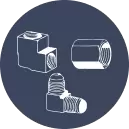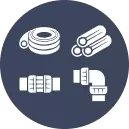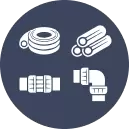Irrigation fittings are the tiny yet influential components of a water system. They assist with delivering water exactly where it is needed, whether on farms, at gardens or for industrial use. These components connect pipes and manage the flow of water so that the system works properly and does not waste any water.
The Role of Irrigation Fittings
Fittings are very important for a water system. They connect pipes, regulate water flow, and aid in distributing water evenly. Even the best water system would fail to operate without these fittings. They are made to:
- Conserve Water: It controls the flow of water, thereby reducing waste.
- Flush Systems: They stop leaks in the pipes.
- Last Longer: They are designed to withstand the elements, including direct sunlight.
- Keep Installation Simple: They come in simple forms to install and repair.
Different Types of Irrigation Fittings
Different types of irrigation fittings are available. They are for multiple purposes in a water system. This section covers the major kinds and what to use them for.
1. Connectors and Couplings
Connectors are components that connect pipes and tubes. They ensure that water moves effortlessly through the system. The most common types are:
- Compression Fittings: These are used to form tight joints without the need for welding.
- Push-to-Connect Fittings: These fittings snap together quickly, saving installation time.
- Threaded Fittings: They provide strong joints by which, connections can be easily taken apart and assembled again.
2. Valves and Flow Controls
Valves control the amount of water entering the system. Although they are simple water systems, they are also critical to complex ones. There are several different types of valves:
- Ball Valves: These valves have the reputation of being simple to operate and they are best for shutting off the flow of water quickly.
- Gate Valves: They are used when maintaining the water pressure is a crucial thing.
- Solenoid Valves: The remote ones are called solenoid valves and are commonly used in automated systems.
3. Special Fittings for Unique Needs
Besides these basic connectors and valves, there are some specific fittings for certain needs. These include:
- Elbows and Tees: These fittings cause a change in the direction of the water flow and divide the water into different paths.
- Reducers and Expanders: They connect differently sized pipes without turbulence in the joint.
- End Caps and Plugs: These are used to finish the ends of the water system and prevent leaks.
Materials and How They Are Made
The quality of irrigation fittings is determined from the material used and the quality of its production. There are two primary materials for these fittings: high-density polyethylene (HDPE), and metals – mostly brass and stainless steel.
High-Density Polyethylene (HDPE)
High-Density Polyethylene (HDPE) is a lightweight and very strong plastic. That's why HDPE fittings are widely used, as they are strong and resistant to extreme weather.
Brass and Stainless Steel
Brass and stainless steel accessories are used where higher strength is essential. They particularly shine under stressful situations and do not oxidize all that readily.
Modern Advances and Innovation
Over the years, the design, as well as the production of irrigation fittings, has come a long way. New technologies have made them more efficient and easier to use.
Automation and Smart Technology
Smart irrigation systems are now commonplace. These are systems that automatically control the water flow using technology. Digital control systems are compatible with some irrigation fittings and offer numerous advantages. Overall, automation brings more efficiency to irrigation systems as the use of this raw material becomes more judicious.
Precision Engineering
Irrigation fittings are precision engineered and tested for performance under pressure. The fittings are designed to function efficiently with a minimal loss of pressure. Irrigation fittings are built to last, thanks to modern engineering.
Easy Installation and Maintenance
A good water system is tough, efficient and simple to install and maintain. Many of the irrigation fittings are manufactured keeping these goals in mind.
Quick and Simple Assembly
Fittings are designed for simpler assembly, whether it's a professional or someone with experience building the home.
- Most fittings can be connected without special tools.
- The components are built to lock into one another with ease, thus minimizing installation time and cost.
- Fittings include simple guides that help ensure that users install them properly.
Easy Maintenance
When the fittings are designed well, maintaining a water system is easy. The system needs regular servicing for it to continuously run seamlessly.
- The fittings can be disassembled quickly for cleaning and maintenance.
- Better quality materials don’t require parts to be replaced as often.
- Most suppliers provide manuals and help answer any maintenance queries.
Environmental Benefits and Water Saving
Water is a precious resource. The irrigation fittings aid in the assurance that the water is utilized in an optimal manner.
Saving Water
Efficient water systems prevent waste. Smart fittings manage how water flows, so no drop goes unused.
- They use special sealing methods to keep the water inside.
- Movable connections ensure water gets just where it needs to go.
- Good water control in farming and gardening means less water is wasted and saves costs.
Saving Energy
When they are functioning well, modern water systems require less energy. Smart irrigation fittings assist with this process.
- When water flow is auto adjusted, pumps and other devices operate less.
- Using less energy as water is supplied more efficiently.
- Using recyclable materials such as HDPE can help lessen the burden on the environment.
In Summary
Irrigation fittings are necessary components of any water administration framework. They connect pipe together, they help control water flow, make sure that water is spent the way it should be. Fittings are available in a variety form and are composed of heavy-duty materials such as HDPE, brass, and stainless-steel.
The homes are built with modern technology and smart systems that conserve water and energy. Their simple installation and low maintenance needs have made them popular for farms, gardens, parks and commercial projects. These components enable water systems to become more reliable, economical, and sustainable.









